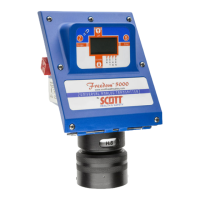19
087-0020 REV E
Sensor Oxygen Requirements
Scott Safety “traditional” (not Rock Solid) gas sensors require a
minimum of 5% oxygen for continuous operation under ambient
conditions (except the Model 80 Oxygen sensor). Sensors operating
in conditions of less than 5% oxygen will provide erroneous or unstable
concentration data.
Beyond the 5% minim
um oxygen concentration requirement, all
“traditional” Hydride sensors (Arsine, Diborane, Germane, Hydrogen
Selenide, Phosphine, Silane) require constant oxygen concentration
when performing sensor calibration. Fluctuating oxygen concentration
during calibration will result in erroneous concentration readings during
system operation.
Note: The above does not apply to the Scott Safety Rock Solid sensors.
Sensor Intrinsic Safety
An Intrinsically safe circuit is simply defined as” ...an electrical circuit
which does not contain, or store, enough energy to cause ignition of a
given explosive atmosphere”. GasPlus sensors are designed as
intrinsically safe and, with the transmitter incorporating a remote safety
barrier, can be removed from the transmitter sensor housing within
explosive environments. These include Division 1 or Zone 0 areas.
Note: Barrier must be installed in a non-hazardous location. Freedom
™
5000 expects to receive third party certification for hazardous protection
by July of 2001.
Sensor Handling and Disposal
Do not attempt to disassemble the sensor in any way. The GasPlus
sensor contains various chemicals/electrolytes. Skin and eye contact
should be avoided and should be considered hazardous.
Touching the membrane should be avoided as this can cause
damage to the sensor.
The GasPlus sensor can be disposed of as ordinary trash with no special
precautions. Incineration in a municipal/commercial incinerator poses no
hazard.
SPECIAL NOTE! The Rock Solid hydride sensor contains a strong acid and
should be handled with caution if electrolyte is leaking.
Freedom 5000 Universal Analog Toxic Gas Detector
Instruction Manual

